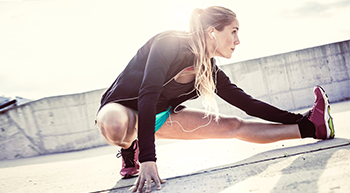I Exercise A Lot, Which Means Yeast Infections Can Be Part of Life
I’m super active, and while being active can lead to many positive results, it can sometimes lead to a few not-so-good results. Like vaginal yeast infections. Yeast thrives in warm, moist environments in the vaginal area. Sweat from physical activity, wet swimsuits after swimming laps, and tight spandex or nylon underwear can contribute to warm, moist environments that help yeast to thrive. If you’re active like me, and you get yeast infections, the good news is, there’s something you can do about it.
So why do girls get yeast infections?
Yeast infections are due to the overgrowth of yeast in the vagina, and they happen because there’s either too much food for the yeast (like hormones) or the “good bacteria” keeping the yeast levels in check have been wiped out. Here are some possible yeast infection causes:
Too much food for yeast to grow…
- Menstruation: Changes in hormone levels during a normal menstrual cycle can result in occasional or recurrent yeast infections.
- Increased Estrogen Levels: Women who are taking birth control pills that have a high-dose of estrogen as well as those on estrogen hormone therapy are more susceptible to developing a yeast infection.
- Pregnancy: Increased levels of estrogen during pregnancy make women more susceptible to yeast infections.
- Diabetes: Whether controlled or uncontrolled, diabetes puts women at higher risk for developing a yeast infection because of the extra glucose that’s not being properly metabolized.
Not enough bacteria to keep yeast in check…
- Antibiotics: Broad-spectrum antibiotics kill healthy lactobacillus bacteria (“good bacteria”) in the vagina, which enables yeast to overgrow.
- Cancer Treatments: Undergoing chemotherapy treatments creates a greater risk for developing a yeast infection.
- Impaired Immune System: Women with weakened immunity from corticosteroid therapy or HIV infections are at greater risk for developing a yeast infection.
Here’s how to help prevent yeast infections
- Change out of wet swimsuits and exercise clothes as soon as you can
- Avoid scented hygiene products like bubble bath, sprays, pads, and tampons
- Change tampons and pads often during your period
- Avoid tight underwear or clothes made of synthetic fibers
- Wear cotton underwear and pantyhose with a cotton crotch
- If you keep getting yeast infections, be sure and talk with your doctor


Do you have a yeast infection?
Answer a few questions and find out what your symptoms mean.
Can I still exercise with a yeast infection?
You can exercise while you are taking MONISTAT® 1 Ovule® formula. All other treatments should be taken at night right before bed, and you can expect some leakage with product use. For best results, lie down as soon as possible after inserting the product. This will reduce leakage. You may want to use fragrance-free panty liners or pads to protect your clothing during the time you are using MONISTAT®.
Relieve symptoms faster
There’s no reason why a yeast infection should hold you back from your workout routine! Once you know what it is, the next step is finding out how to treat a yeast infection. After your doctor confirms that it's a yeast infection, reach for MONISTAT®. MONISTAT® is the #1 OTC (over-the-counter) yeast infection brand and relieves yeast infection symptoms 4x faster than the leading prescription pill.
If this is your first yeast infection, it's important to talk with your doctor to confirm the diagnosis. Not sure what to ask? Here are some questions to ask about your first yeast infection.
MONISTAT® 1 treatment is proven in a clinical study to stay in place throughout vigorous activity. That means it keeps working while you work out.
Monistat FAQ
Get answers to questions from women just like you.
